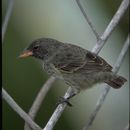Biology
provided by Arkive
The highly adaptive beaks of Darwin's finches enable each species to occupy a different ecological niche based on different food types (2) (4). The foraging behaviour of the common cactus-finch varies with the seasons, but when Opuntia cacti are flowering, the adults use their specialised beaks to feed almost exclusively on the pollen and nectar obtained from the flowers (4) (8). At other times of the year, Opuntia fruits and seeds become important components of its diet, and during the rainy season, this finch will take advantage of various additional sources of food, such as shoots, berries, seeds, caterpillars and budworms (8)
Darwin's finches generally breed opportunistically with egg-laying being most profuse when rainfall is high and food abundant (2). Pairs are typically monogamous and maintain small territories within which they build a small dome-shaped nest in a bush or cactus. On average each clutch comprises three to four eggs that are incubated for around 12 days before hatching. The nestlings are mostly raised on pollen, nectar and insects, and leave the nest after about two weeks (4) (9).
During the breeding season, competition for resources between different species of finch can be extremely intense. In promoting ever increasing levels of specialisation, competition for resources has been the driving force behind the evolution of Darwin's finches. This is exemplified by the widely divergent beak sizes of different finch species co-inhabiting one island, compared with much more convergent beak sizes when the same species are isolated from each other on separate islands (4). Long term studies of Darwin's finches on the island of Daphne Major have provided compelling evidence of evolution in action. Over a period of several decades, the beak morphology of the island's common cactus-finch population has fluctuated in response to changes in the prevalent food source following climatic events (10) (11) (12).
Conservation
provided by Arkive
For their unique biological diversity and significance, the Galapagos Islands are designated both a National Park and a World Heritage Site. As a consequence, conservation of the islands' native fauna and flora is a high priority (15). Furthermore,scientists from the Charles Darwin Foundation continue to conduct further research on Darwin's finches in order to ensure their long-term conservation (13).
Description
provided by Arkive
Although the mockingbirds of the Galapagos arguably had a greater influence on Darwin's theory of natural selection (3), it is a group of fourteen closely related finches that famously bear his eponym (2) (4). One of the most well known of Darwin's finches, and one that the eminent naturalist initially mistook for a kind of blackbird, is the common cactus-finch (4) (5). Like the other ground finches (Geospiza sp.) the adult male plumage of the common cactus finch is usually completely black, while the female is brown and streaked (2). The long, pointed beak of the common cactus-finch enables it to exploit food sources less accessible to the other finches (2) (4) (6).
Habitat
provided by Arkive
Occurs mainly in the arid lowland zone on each island, particularly where Opuntia cacti are abundant (7) (8).
Range
provided by Arkive
The common cactus finch is endemic to the Galápagos where it occurs on the islands of Pinta, Marchena, Floreana, San Cristóbal, Santa Fe, Daphne Major, Santa Cruz, Pinzón, Rábida, Santiago, Isabela, Baltra and Seymour (2).
Status
provided by Arkive
Classified as Least Concern (LC) on the IUCN Red List (1).
Threats
provided by Arkive
Like much of the Galapagos' endemic fauna and flora, Darwin's finches are under threat from habitat destruction, introduced diseases, and invasive predatory species such as rats and cats (13). Fortunately, the common cactus-finch is still relatively abundant in parts of its range and currently is not thought to be undergoing a significant decline (14).
Common cactus finch
provided by wikipedia EN
The common cactus finch or small cactus finch (Geospiza scandens) is a species of bird in the Darwin's finch group of the tanager family Thraupidae. It is endemic to the Galapagos Islands, where it is found on most islands, with the notable exception of Fernandina, Española, Genovesa, Darwin and Wolf. Most of these islands are inhabited by its close relative, the Española cactus finch.
Its natural habitats are dry scrubland and woodland. It is usually closely associated with the cactus Opuntia.
Taxonomy
The common cactus finch is one of nine species in the genus Geospiza, part of a group of closely related species known as Darwin's finches.[2] There are four recognized subspecies:
-
G. s. abingdoni is found on Pinta.[3]
-
G. s. intermedia is found on Santa Fé, Floreana, Santa Cruz, Isabela and Pinzón.[3]
-
G. s. rothschildi is found on Marchesa.[3]
-
G. s. scandens is found on Santiago and Rábida.[3]
Habitat and range
Found in the arid zone of many of the islands in the Galápagos, the common cactus finch is seldom far from areas of Opuntia cactus.[3]
References
Swash, Andy; Still, Rob (2005). Birds, Mammals and Reptiles of the Galápagos Islands (2nd ed.). London: Christopher Helm. ISBN 978-0-7136-7551-1.

- license
- cc-by-sa-3.0
- copyright
- Wikipedia authors and editors
Common cactus finch: Brief Summary
provided by wikipedia EN
The common cactus finch or small cactus finch (Geospiza scandens) is a species of bird in the Darwin's finch group of the tanager family Thraupidae. It is endemic to the Galapagos Islands, where it is found on most islands, with the notable exception of Fernandina, Española, Genovesa, Darwin and Wolf. Most of these islands are inhabited by its close relative, the Española cactus finch.
Its natural habitats are dry scrubland and woodland. It is usually closely associated with the cactus Opuntia.
- license
- cc-by-sa-3.0
- copyright
- Wikipedia authors and editors

